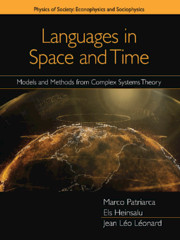Conclusion
Published online by Cambridge University Press: 04 June 2020
Summary
In the present monograph, we have illustrated a set of tools and conceptsrelated to complex systems that are employed in language dynamics. In orderto see how they work and how they relate to linguistics, such tools andconcepts have been applied to specific case studies as well as to moregeneral and abstract simplified models. This application follows the generalpoint of view of complex systems theory, that there are some universalframeworks that can be applied through different fields to describe verydifferent types of complex systems.
Language dynamics is a young field looking for an actual integration amongthe various tools and methods from complex systems, on the one hand, andlinguistics, on the other hand, resulting in a unified and consistentpicture of language change and use. Such a picture is multifold, in that itconcerns (a) the study of the reconstruction of a consistent history oflanguages, (b) the investigations interpreting the complexity of thecurrently observed linguistic landscape, and (c) the forecast of the futureevolution of language groups. The latter point has recently become ofinterest due to the fact that cultural and linguistic diversity are nowrecognized as an invaluable heritage. In fact, the tools of languagedynamics have already been used by various authors to suggest languagepolicies and evaluate the ability of a language to find or create theconditions and a suitable niche, in which to be successful.
The structure and contents of this book reflect the current situation: anintegration of the main methods of investigation has began, but it is stillunderway. The path toward the goals of language dynamics is long andnecessarily passes through a series of applications to real life situationsand historical tests, which are represented by the many linguistic databasesnow available, containing data about the history of languages and thecurrent sociolinguistic structures. We have not mentioned, for reasons ofspace, all the databases coming from social networks or from onlinecontents, which offer ‘big data’ with an unprecedented amountof information and a unique level of fine-grained detail, which are by now arelevant element in linguistic analysis—see for example,Gonçalves and Sánchez (2014); Donoso and Sánchez(2017); Paradowski (2010); Paradowski et al. (2012).
Information
- Type
- Chapter
- Information
- Languages in Space and TimeModels and Methods from Complex Systems Theory, pp. 177 - 178Publisher: Cambridge University PressPrint publication year: 2020
